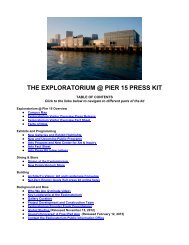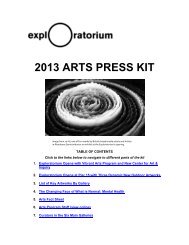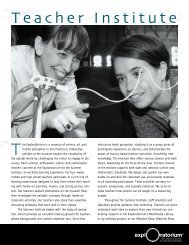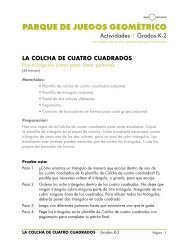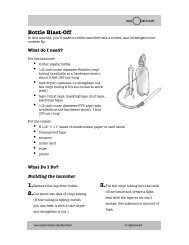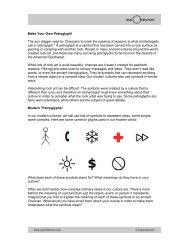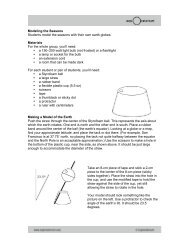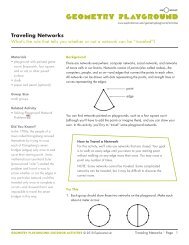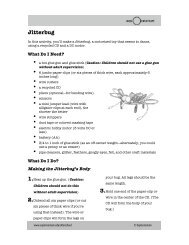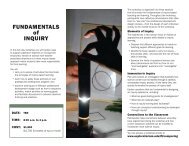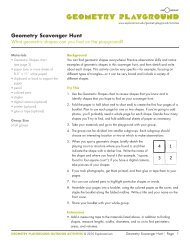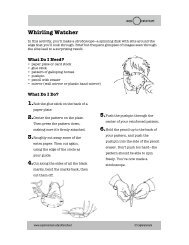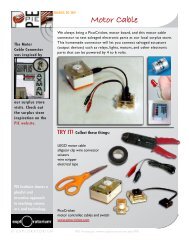Download the Kinetic Contraptions PDF - Exploratorium
Download the Kinetic Contraptions PDF - Exploratorium
Download the Kinetic Contraptions PDF - Exploratorium
You also want an ePaper? Increase the reach of your titles
YUMPU automatically turns print PDFs into web optimized ePapers that Google loves.
A T E L I E R D O C U M E N T A T I O N<br />
K I N E T I C<br />
C O N T R A P T I O N S<br />
AT THE EXPLORATORIUM<br />
JANUARy 22 - JANUARy 25, 2006
A T E L I E R D O C U M E N T A T I O N<br />
The PIE Institute is a museum collaboration offering<br />
professional development opportunities for informal<br />
educators to explore new approaches to teaching<br />
science, art, and technology.<br />
h t t p : / / w w w. e x p l o r a t o ri u m . e d u / p i e<br />
KINETIC CONTRAPTIONS<br />
January 22 - January 25, 2007<br />
At <strong>the</strong> <strong>Exploratorium</strong><br />
San Francisco, CA<br />
Workshop Overview<br />
Atelier defined............................................3<br />
<strong>Kinetic</strong> <strong>Contraptions</strong> description..............3<br />
Monday..............................................4<br />
Tuesday..............................................5<br />
Wednesday........................................6<br />
Thursday............................................7<br />
CONTENTS<br />
Workshop Details<br />
Monday.................................................8-10<br />
Tuesday......................................................11<br />
Wednesday.........................................12-14<br />
Thursday...................................................15<br />
Artist-in-Residence.................................16<br />
Online Resources.....................................17<br />
Cover image: Math and <strong>the</strong> Night Sea: The Round Wave, by Reuben Heyday Margolin October 2006 <strong>Exploratorium</strong> Seeing Gallery.<br />
The PIE Institute is made possible by <strong>the</strong> National Science Foundation under Grant No. ESI-0452567.<br />
Any opinions, findings, and conclusions or recommendations expressed in this material<br />
are those of <strong>the</strong> authors and do not necessarily reflect <strong>the</strong> views of <strong>the</strong> National Science Foundation.
a~te*lier<br />
/n. [F] a workshop;<br />
a studio for an artist<br />
or designer.<br />
PIE Institute Ateliers<br />
explore new educational<br />
activities utilizing digital<br />
technologies, and provide<br />
opportunities to share <strong>the</strong><br />
PIE philosophy of<br />
teaching and learning.<br />
The <strong>Kinetic</strong> <strong>Contraptions</strong> Atelier was<br />
for museum and out-of-school educators<br />
who wanted to combine art, science, and<br />
technology in exhibits, workshop activities,<br />
and museum public programs.<br />
Participants explored <strong>Kinetic</strong> Contraption<br />
projects as learners, <strong>the</strong>n deconstructed<br />
<strong>the</strong> activities in order to better understand<br />
how <strong>the</strong>y are developed and tailored for<br />
diverse educational and audience needs.<br />
Projects included constructing marble<br />
runs, building computer-controlled kinetic<br />
devices, playing with light and shadow,<br />
contributing to a chain reaction<br />
contraption, and o<strong>the</strong>r activities.<br />
3
W H AT H A P P E N E D M O N DAY<br />
Clockwise from top: Lani and Anita<br />
collaborate on <strong>the</strong>ir marble machine;<br />
Detail of an integrated PicoCricket;<br />
Sam waits for <strong>the</strong> ball to drop.<br />
We constructed marble runs out of common materials, <strong>the</strong>n introduced technology as<br />
an optional way to add new kinetic elements to <strong>the</strong> activity.<br />
“I like <strong>the</strong> process of messing around. I like how you make something, and <strong>the</strong>n you make<br />
something else, and <strong>the</strong>n you have to go back and adjust <strong>the</strong> whole thing.” Vayu<br />
4
W H AT H A P P E N E D T U E S DAY<br />
Tuesday began<br />
with participants<br />
exploring a<br />
variety of<br />
shadow and light<br />
stations, as a<br />
way of becoming<br />
familiar with <strong>the</strong><br />
phenomena.<br />
We spent <strong>the</strong> afternoon constructing interactive shadow and light contraptions, in order<br />
to dramatically transform a space.<br />
“I was inspired by <strong>the</strong> exhibits where <strong>the</strong> effects were created accidentally. I like incomplete<br />
things that have a lot of potential to become something.” Brenda<br />
Vayu explores shadows and<br />
moire patterns.<br />
Anne starts her<br />
interactive light room<br />
with a roll of paper and<br />
a strawberry basket.<br />
5
WHAT HAPPENED WEDNESDAY<br />
The day<br />
started with<br />
a discussion<br />
about <strong>the</strong><br />
pedagogy of<br />
PIE activities.<br />
Participants<br />
<strong>the</strong>n explored<br />
a variety of<br />
home-made<br />
inputs and<br />
outputs.<br />
The chain reaction activity was introduced in <strong>the</strong> afternoon, and participants started by<br />
building on <strong>the</strong> <strong>the</strong>me: Machines that demonstrate LOVE.<br />
“The demonstrations of <strong>the</strong> various home-made<br />
switches and relays opened it all up. It made so many<br />
new things seem possible.” Lani<br />
6
WHAT HAPPENED THURSDAY<br />
We completed our individual chain reaction elements, <strong>the</strong>n connected <strong>the</strong>m toge<strong>the</strong>r and<br />
started <strong>the</strong> Love Machine chain reaction.<br />
Our final discussion was an<br />
opportunity for everyone to share<br />
<strong>the</strong> big ideas from <strong>the</strong> week that<br />
<strong>the</strong>y plan to bring back to <strong>the</strong>ir<br />
home institutions.<br />
“The use of <strong>the</strong> love metaphor with <strong>the</strong> Chain<br />
Reaction activity gave <strong>the</strong> whole process a richness<br />
of language, an embedded aes<strong>the</strong>tic.” Sam<br />
7
A T E L I E R I N - D E P T H<br />
Atelier Goals<br />
• To share a set of new and established PIE activities<br />
• Demonstrate <strong>the</strong> integration of artists in <strong>the</strong> development<br />
of PIE activities.<br />
• Model ways of integrating technologies into phenomena-based,<br />
PIE activities.<br />
Atelier Context<br />
Technology has an important role in PIE philosophy and practice,<br />
but technology is not <strong>the</strong> main focus or even <strong>the</strong> main tool of PIE’s<br />
work. PIE Ateliers offer opportunities to gain greater understanding<br />
and facility with digital technologies such as <strong>the</strong> Cricket, computers,<br />
cameras, and cell phones, as well as with power tools such as drills<br />
and skill saws.<br />
Technological skills and literacy are important to <strong>the</strong> pedagogical<br />
goals of PIE, but <strong>the</strong>y are just two aspects among many. The empha-<br />
sis in PIE is on working with simple materials and real natural phe-<br />
nomena. Technologies, whe<strong>the</strong>r mechanical or digital, are introduced<br />
to advance ideas that begin with more basic explorations.<br />
M O N D A Y O V E R V I E W<br />
Monday’s Theme<br />
Marble Machines: no tech, low tech, and high tech.<br />
Monday’s Goals<br />
Participants became familiar with <strong>the</strong> first PIE activity. Facilitators<br />
model <strong>the</strong> integration of PicoCricket contraptions into <strong>the</strong> “no-<br />
tech” Marble Machines activity. We introduced Bernie Lubell, artist<br />
in residence at <strong>the</strong> <strong>Exploratorium</strong> and workshop facilitator.<br />
8
M O N D A Y A C T I V I T I E S<br />
Marble Machines<br />
Participants used common materials from a local hardware<br />
store to build marble runs. The familiar materials were used in<br />
unusual and creative ways by teams of participants building<br />
contraptions that allowed <strong>the</strong> marble to travel as slowly as<br />
possible from <strong>the</strong> top to <strong>the</strong> bottom of <strong>the</strong>ir run.<br />
PicoCricket Introduction<br />
Some participants in <strong>the</strong> group utilized Pico Crickets, motors, and<br />
salvaged switches to create interactive kinetic elements such as<br />
elevators, ball starters, moving ramps, and creative inventions like<br />
dowel mazes, funnel basins, and fea<strong>the</strong>r flingers.<br />
www.picocricket.com<br />
9
M O N D A Y T H O U G H T S<br />
From Facilitators<br />
“We want you to learn something about mechanisms, about how<br />
to set up a workshop space, how and why we use different materials.<br />
Later in <strong>the</strong> workshop we’ll be asking you to help us unpack <strong>the</strong> activities,<br />
to think about how <strong>the</strong>y relate to process skills in science, to relate what<br />
you notice about facilitation, and to think about how you would adapt <strong>the</strong>m<br />
to your own institution and audiences. ” (Mike)<br />
“ We set up a situation that minimizes <strong>the</strong> focus on outcome. We create <strong>the</strong><br />
conditions for kids and adults to really love what <strong>the</strong>y’re making.” (Kristen)<br />
From Participants<br />
“There’s something about <strong>the</strong> marble on <strong>the</strong> track. You just naturally want to<br />
fix it. It’s inherently interesting.” (Elib)<br />
“I think <strong>the</strong> teamwork was really important. You learn from your partner. You<br />
share ideas.” (Lynne)<br />
“It’s like learning a new language. Every time you learn something, you have a<br />
new tool.” (Andrea)<br />
10
T U E S D A Y O V E R V I E W<br />
Tuesday’s Theme<br />
Light Play: Aes<strong>the</strong>tics and <strong>the</strong> transformation of space.<br />
Goals<br />
Participants explored light and shadow as pure phenomena Then, inspired<br />
by László Moholy-Nagy and o<strong>the</strong>r artists, <strong>the</strong>y transformed <strong>the</strong> workshop<br />
environment with interactive light and shadow projections. We discussed PIE<br />
activities in relation to David Hawkin’s “Messing About in Science” article.<br />
T U E S D A Y A C T I V I T I E S<br />
Light Play Starting points<br />
Participants rotated through four “starting point” stations for <strong>the</strong> light play<br />
activity. Each station focused on different aspects of light and shadow.<br />
Station 1 Shadow moiré patterns were explored using handheld pinpoint<br />
sources of light, window screening, plastic grids, and o<strong>the</strong>r patterns printed<br />
on transparencies.<br />
Station 2 Barry led a “Shadow-Making Devices” exhibit floor walk through<br />
<strong>the</strong> <strong>Exploratorium</strong>. (<strong>Download</strong> Barry’s Floor Walk Map)<br />
Station 3 Shadows were projected on a variety of surfaces including white<br />
balloons, rolled corrugated cardboard, bed sheets swaying in <strong>the</strong> wind from<br />
a small fan, framed shower curtains, and several translucent materials.<br />
Station 4 Shadow-making objects and a variety of light sources were<br />
placed on slow-moving turntables, creating slowly changing light and shadow<br />
displays.<br />
Light Play Setting <strong>the</strong> context<br />
Jeannette presented a selection of light and shadow explorations by artists,<br />
<strong>the</strong>n Liz Keim screened Lightplay, an abstract film by László Moholy-Nagy.<br />
(<strong>Download</strong> Jeannette’s presentation)<br />
Light Play Transforming <strong>the</strong> environment<br />
Participants utilized experiments from <strong>the</strong> starting point stations, and Pico<br />
Crickets to create interactive light and shadow installations, ultimately transforming<br />
<strong>the</strong> environment of <strong>the</strong> classroom.<br />
11
W E D N E S D AY D I S C U S S I O N<br />
Messing About in Science Discussion<br />
Barry led a discussion about <strong>the</strong> connections between PIE<br />
activities and David Hawkin’s article, “Messing About in Science.“<br />
(<strong>Download</strong> <strong>the</strong> David Hawkins article)<br />
Barry led <strong>the</strong> discussion with <strong>the</strong> following prompts:<br />
Prompt 1<br />
Discuss your reaction to <strong>the</strong> “Messing About in Science” article. What stood<br />
out for you? What did it make you think about?<br />
Prompt 2<br />
You have now had <strong>the</strong> opportunity to experience several PIE activities. Discuss<br />
<strong>the</strong> commonalities and differences between Hawkins’s messing about<br />
phase and PIE activities.<br />
Prompt 3<br />
In what ways do you think that PIE activities contribute to learning?<br />
W E D N E S D A Y T H O U G H T S<br />
From Facilitators<br />
“This is <strong>the</strong> ultimate in continuous experimentation.” (Mike)<br />
“It was about aes<strong>the</strong>tic experiences, not about making a functioning object.”<br />
(Karen)<br />
“Even in unstructured activities <strong>the</strong>re are in fact structures. It’s <strong>the</strong> underlying<br />
structure that creates <strong>the</strong> freedom. And it’s incumbent on those who set<br />
up <strong>the</strong> workshop to really think through that underlying structure.” (Barry)<br />
“They were trying to create a relic of <strong>the</strong>ir own creativity. Something that<br />
would give <strong>the</strong>m pleasure. A lot of people tried to replicate some aspect of<br />
an experience that <strong>the</strong>y saw earlier in <strong>the</strong> day.” (Walter)<br />
From Participants<br />
“The starters really make a difference. I did my light project without having<br />
done <strong>the</strong> starters. I didn’t have a ready sense of what to do, or which of <strong>the</strong><br />
boards, materials, and screens I wanted to use.” (Barry)<br />
“Some of <strong>the</strong> kids are really intimidated by science. Setting up <strong>the</strong> activity<br />
as a playful experiment takes away some of <strong>the</strong> intimidation factor. No one’s<br />
going to be saying, you failed.” (Andrea)<br />
“Sometimes we present activities that have rules. But what happens before<br />
you introduce <strong>the</strong> rules?” (Elib)<br />
12
W E D N E S D A Y O V E R V I E W<br />
Wednesday’s Theme<br />
Inputs and Outputs: Sensing <strong>the</strong> world around you.<br />
Goals<br />
Participants discussed <strong>the</strong> pedagogy of PIE activities. We extended <strong>the</strong> Pico<br />
Cricket kit by sharing examples of homemade sensors and actuators. In <strong>the</strong><br />
afternoon we introduced <strong>the</strong> chain reaction activity based on <strong>the</strong> <strong>the</strong>me of LOVE.<br />
W E D N E S D AY D I S C U S S I O N<br />
PIE Pedagogy Discussion<br />
Participants shared ideas about <strong>the</strong> pedagogical implications of PIE activities.<br />
(<strong>Download</strong> <strong>the</strong> Pie Pedagogy Discussion and Responses Powerpoint)<br />
W E D N E S D A Y A C T I V I T I E S<br />
Inputs and Outputs<br />
Participants rotated through three stations, each exploring a type of homemade<br />
input or output that can be utilized with <strong>the</strong> PicoCricket. Stations included:<br />
Station 1<br />
INPUTS - Switches. Salvaged and home-made switches, including tinfoil and<br />
metal switches, bucket switches, and unusual switches such as telephone dials<br />
and magnet switches were explored.<br />
Station 2<br />
INPUTS/VARIABLE RESISTORS - Common found objects became variable<br />
resistors when connected to <strong>the</strong> PicoCricket. Variable resistors included soap<br />
bubbles, conductive foam padding, graphite, dimmer switches, bend sensors,<br />
and pickles.<br />
Station 3<br />
OUTPUTS - Lights, motors, relays, buzzers, fans, water pumps, and o<strong>the</strong>r devices<br />
that can be powered by 4 volts, were connected to <strong>the</strong> PicoCricket.<br />
Inputs were connected and tested using <strong>the</strong> Pico resistance sensor (see image).<br />
Outputs were connected and tested using <strong>the</strong> Pico motor board (image) and<br />
our homemade motor connector cable (see image or make your own motor<br />
connector cable ).<br />
Chain Reaction Setting <strong>the</strong> context<br />
Bernie Lubell and Karen led <strong>the</strong> introduction discussion by sharing Rube<br />
Goldberg and Bruno Munari sketches of metaphorical chain reaction contraptions.<br />
Participants <strong>the</strong>n brainstormed and chose <strong>the</strong>ir own phrases and<br />
words associated with <strong>the</strong> <strong>the</strong>me of LOVE.<br />
Chain Reaction Building <strong>the</strong> elements<br />
Favorite words were chosen by each participant pair, <strong>the</strong>n design and construction<br />
began on machines that demonstrated LOVE.<br />
13
W E D N E S D A Y T H O U G H T S<br />
From Facilitators<br />
“The morning demos were relaxed. There were fewer materials and<br />
a more focused purpose.” (Barry)<br />
“Using language as a starting point opened up <strong>the</strong> conversations.” (Bernie)<br />
“The fact that Bernie’s opening example didn’t work perfectly actually ended<br />
up being a positive thing for <strong>the</strong> workshop. It made people more at ease.”<br />
(Karen)<br />
From Participants<br />
“Each part of <strong>the</strong> inputs and outputs explorations this morning was presented<br />
in a way that made it easy for us to understand and to feel comfortable<br />
playing with <strong>the</strong> different components. If it had been all combined and just<br />
thrown at use at once, it would have been overwhelming.” (Vayu)<br />
“What you did today, with <strong>the</strong> explorations of inputs and outputs and relays<br />
and motors blew away a lot of barriers that I had about using <strong>the</strong> Cricket.<br />
Now I can see lots of ways to use it.” (Andrea)<br />
“You know that everyone is going through <strong>the</strong> same thing while building <strong>the</strong>ir<br />
machines. You know that it’s going to be OK if it doesn’t work perfectly.”<br />
(Skoshi)<br />
“We feed off each o<strong>the</strong>r’s ideas.” (Toni)<br />
“This is an activity that can accommodate a wide range of skills.” (John)<br />
14
T H U R S D A Y O V E R V I E W<br />
Thursday’s Theme<br />
Chain Reaction: Mixing metaphor and motion.<br />
Thursday’s Goals<br />
Participants completed construction of chain reaction elements. We set off<br />
<strong>the</strong> chain reaction as a group activity. Later we processed PIE activities and<br />
atelier elements, and discussed next steps for participants.<br />
T H U R S D A Y A C T I V I T I E S<br />
Chain Reaction Finishing <strong>the</strong> elements, setting it off<br />
Participant teams finished <strong>the</strong>ir elements, <strong>the</strong>n connected <strong>the</strong>m to one ano<strong>the</strong>r<br />
so <strong>the</strong> group could share <strong>the</strong> complete chain reaction performance.<br />
Chain Reaction Debrief discussion<br />
We had an informal conversation about <strong>the</strong> chain reaction PIE activity.<br />
Discussion prompt: “Talk about <strong>the</strong> design and construction of your chain<br />
reaction element, and highlight skills, attitudes, and content used to complete<br />
your love machine.”<br />
PIE Reflections and Planning Discussion<br />
This discussion shared participants’ plans to continue PIE investigations at<br />
<strong>the</strong>ir home institutions.<br />
Discussion Prompt<br />
“Think about how you plan to continue PIE activity at your institution.<br />
What do you plan to do Monday? What do you hope to do someday?”<br />
T H U R S D A Y T H O U G H T S<br />
From Facilitators<br />
“The initial process of brainstorming was a good way to get things focused.<br />
The <strong>the</strong>me was rich, with lots of variety.” (Mike)<br />
From Participants<br />
“The love <strong>the</strong>me really worked. It was great to have to explain emotions<br />
through mechanics.” (Vayu)<br />
“In working on <strong>the</strong> chain reaction today, I noticed that I was working on<br />
something on my own, but I was also excited to know that it was going to be<br />
a part of a bigger activity later on.” (Elib)<br />
“A big part of what I took away from <strong>the</strong> workshop was a stronger awareness<br />
of my own process of working. I became aware of <strong>the</strong> progression of working<br />
with materials, getting stuck, and working through it. The discussions gave<br />
me a chance to reflect and think about that.” (Sylvia)<br />
15
A T E L I E R R E S O U R C E S<br />
ARTIST RESIDENCIES<br />
PIE works with artists to explore new ways of using materials,<br />
new approaches to design problems, and new techniques for<br />
presenting phenomena. We worked closely with Bernie Lubell<br />
to design and facilitate <strong>the</strong> chain reaction activity. Bernie also<br />
installed A Little Breathing Room for atelier participants and museum<br />
visitors to experiment with during <strong>the</strong> week.<br />
Bernie Lubell makes interactive installations that provoke <strong>the</strong> silly and playful kines<strong>the</strong>tic comprehensions<br />
of childhood in service of philosophical explorations of <strong>the</strong> nature of consciousness and <strong>the</strong> origins of life.<br />
Working in an adamantly low-tech mode, he constructs sculptures from wood, latex, wire, and rope. The<br />
works use nei<strong>the</strong>r computers nor motors, but are ra<strong>the</strong>r entirely powered by visitors. As people work toge<strong>the</strong>r<br />
to animate <strong>the</strong> mechanisms, <strong>the</strong>ir rocking, pressing, pedaling, cranking, pulling, and breathing engages<br />
bodies as well as minds in constructing understandings.<br />
http://blubell.home.att.net<br />
A Little Breathing Room - Bernie Lubell (2007)<br />
16
O N L I N E R E S O U R C E S<br />
Supplemental Materials<br />
Browse <strong>the</strong> list below to download documents from <strong>the</strong><br />
<strong>Kinetic</strong> <strong>Contraptions</strong> workshop. You can also review all of <strong>the</strong> websites<br />
referenced in <strong>the</strong> text of this document alongwith o<strong>the</strong>r connections<br />
we find inspiring.<br />
W E B S I T E S<br />
URLs<br />
Pie Website www.exploratorium.edu/pie<br />
More about Marble Machines Click for <strong>the</strong> online version<br />
PicoCricket www.picocricket.com<br />
Bernie Lubell http://blubell.home.att.net<br />
Der Lauf der Dinge<br />
(The Way Things Go)<br />
1986-87, 30 min<br />
by Peter Fischli and David Weiss Available at www.amazon.com<br />
Rube Goldberg www.rube-goldberg.com<br />
Arthur Ganson www.arthurganson.com<br />
George Rhoads www.georgerhoads.com<br />
I M A G E G A L L E R Y<br />
VIEW AND DOWNLOAD IMAGES FROM THE<br />
KINETIC CONTRAPTIONS<br />
GALLERY<br />
http://www.exploratorium.edu/pie/gallery/kinetic<br />
D O W N L O A D S<br />
Resources<br />
Participant List (560 kb) <strong>Kinetic</strong> <strong>Contraptions</strong> Journal (44.9 mb)<br />
Short Schedule (2.1 mb) Mitchel Resnick Article (108 kb)<br />
Pie Pedagogy Presentation (492 kb) Marble Machines <strong>PDF</strong> (1 mb)<br />
David Hawkins Article (84 kb)<br />
Jeannette’s Artists and Light Presentation (100kb)<br />
Barry’s Floor Walk Map (876 kb)<br />
17



